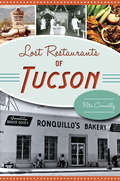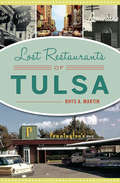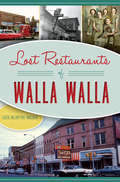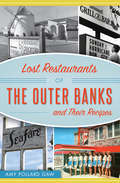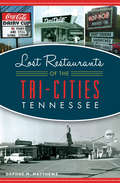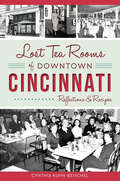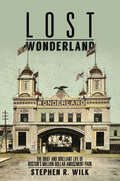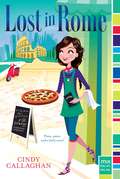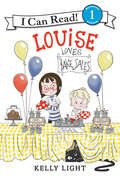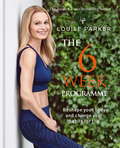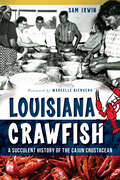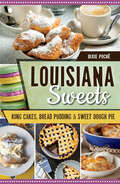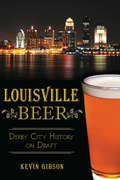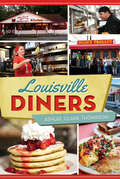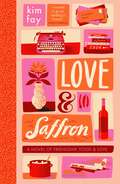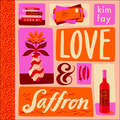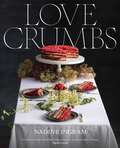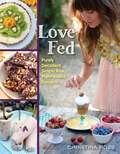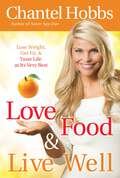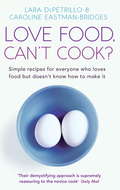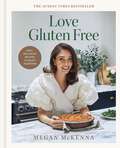- Table View
- List View
Lost Restaurants of Tucson (American Palate)
by Rita ConnellyFrom western roadhouses to fine dining, Tucson boasts an extraordinary lineup of diverse restaurants. Though some of its greatest no longer exist, their stories conjure the sights, smells and sounds of the city's history. Longtime locals still buzz about Gordo's famous chimichangas, an accidental dish originating in Tucson. The legendary Tack Room was a beacon of fine dining. Places like Café Terra Cotta and Fuego pioneered a new southwestern cuisine, serving regional dishes like prickly pear pork and stuffed poblanos. University of Arizona alumni miss old spots like the Varsity, while long-gone haunts like Gus & Andy's attracted a unique crowd of businessmen, movie stars and the occasional mobster. Join local food writer Rita Connelly as she serves up savory stories of good food and good company from the gone but never forgotten favorites of the Old Pueblo.
Lost Restaurants of Tulsa (American Palate)
by Rhys A. MartinIn the early twentieth century, Tulsa was the "Oil Capital of the World." The rush of roughnecks and oil barons built a culinary foundation that not only provided traditional food and diner fare but also inspired upper-class experiences and international cuisine. Tulsans could reserve a candlelit dinner at the Louisiane or cruise along the Restless Ribbon with a pit stop at Pennington s. Generations of regulars depended on family-owned establishments such as Villa Venice, The Golden Drumstick and St. Michael's Alley. Join author Rhys Martin on a gastronomic journey through time, from the Great Depression to the days of "Liquor by the Wink" and the Oil Bust of the 1980s.
Lost Restaurants of Tulsa (American Palate)
by Rhys A. MartinIn the early twentieth century, Tulsa was the "Oil Capital of the World." The rush of roughnecks and oil barons built a culinary foundation that not only provided traditional food and diner fare but also inspired upper-class experiences and international cuisine. Tulsans could reserve a candlelit dinner at the Louisiane or cruise along the Restless Ribbon with a pit stop at Pennington's. Generations of regulars depended on family-owned establishments such as Villa Venice, The Golden Drumstick and St. Michael's Alley. Join author Rhys Martin on a gastronomic journey through time, from the Great Depression to the days of "Liquor by the Wink" and the Oil Bust of the 1980s.
Lost Restaurants of Walla Walla (American Palate)
by Catie McIntyre WalkerDining in Walla Walla blossomed from an influx of mining transplants in the late 1800s. Within decades, a roadhouse called the Oasis boasted a seventy-two-ounce slab of beef, and the old Pastime Café opened at 5:30 a.m. with white toast and whiskey for breakfast. In the early 1950s, Ysidro Berrones opened one of the valley's first Mexican restaurants, the El Sombrero Tortilla Factory and Café. Owner of Denney's Hi-Spot for two decades, Joe Denney also satisfied locals with his morning crooning to piano on KTEL. Native and local wine writer Catie McIntyre Walker celebrates this rich heritage with decades of departed, beloved establishments and the people behind them.
Lost Restaurants of the Outer Banks and Their Recipes (American Palate)
by Amy Pollard GawAnyone who has lived or vacationed on the Outer Banks has an old favorite restaurant. Hundreds have opened over many decades and then closed thanks to changing tastes and the vagaries of a seasonal business. Manteo locals loved Miss Esther's, and midcentury visitors came to stay at the Sea Ranch and sample Alice Sykes's famed crab bisque. Residents will remember quirky favorites like the Pit and Papagayo's. the Seafare, The Oasis and Kelly's were beloved by generations of families. Join Amy Pollard Gaw as she tells tales and presents classic recipes from gone but not forgotten spots.
Lost Restaurants of the Tri-Cities, Tennessee (American Palate)
by Daphne M. MatthewsThe Tri-Cities has been blessed with fame-worthy eateries that have helped shape the area's identity. Elvis shimmied through the area during his up-and-coming years, making for one incredibly happy girl and her not-so-happy boyfriend. Broadwater Drug Stores served hamburgers that brought in customers from miles around. Hungry patrons had to arrive very early at Mountaineer Restaurant or they wouldn't find a place to park. Home Sweet Home and the Mezzanine Tea Room offered homey atmospheres and had the best quiche in the area. Visitors to Skoby's World were treated to a culinary trip around the world. Author Daphne Matthews details the delectable stories of the most iconic restaurants in the Tri-Cities' past.
Lost Tea Rooms of Downtown Cincinnati: Reflections & Recipes (American Palate)
by Cynthia Kuhn BeischelIt was a different time. Ladies wore gloves, hats and nice attire to luncheons at the Woman's Exchange. Shillito's provided a cosmopolitan environment for its patrons, while Mullane's was the perfect place to sip and socialize. The popular Good Morning Show radio program hosted by charming Bob Braun, and later Nick Clooney, was broadcast from McAlpin's Tea Room. Women gathered at Pogue's and Mabley & Carew tea rooms to celebrate birthdays, as well as wedding and baby showers, over dainty tea sandwiches. Author Cynthia Kuhn Beischel brings the Queen City's bygone downtown tea rooms back to life and shares more than one hundred beloved recipes.
Lost Wonderland: The Brief and Brilliant Life of Boston's Million Dollar Amusement Park
by Stephen R. WilkIf you take Boston's Blue Line to its northern end, you'll reach the Wonderland stop. Few realize that a twenty-three-acre amusement park once sat nearby—the largest in New England, and grander than any of the Coney Island parks that inspired it. Opened in Revere on Memorial Day in 1906 to great fanfare, Wonderland offered hundreds of thousands of visitors recreation by the sea, just a short distance from downtown Boston. The story of the park's creation and wild, but brief, success is full of larger-than-life characters who hoped to thrill attendees and rake in profits. Stephen R. Wilk describes the planning and history of the park, which featured early roller coasters, a scenic railway, a central lagoon in which a Shoot-the-Chutes boat plunged, an aerial swing, a funhouse, and more. Performances ran throughout the day, including a daring Fires and Flames show; a Wild West show; a children's theater; and numerous circus acts. While nothing remains of what was once called "Boston's Regal Home of Pleasure" and the park would close in 1910, this book resurrects Wonderland by transporting readers through its magical gates.
Lost in Rome (mix)
by Cindy CallaghanWhen Lucy heads to Rome for the summer, she’s is in for pizza, pasta, and a little amore in this M!X novel from the author of Lost in London.Lucia “Lucy” Rossi thought she was going to be a camp counselor for the summer, but, thanks to a very fortunate twist, she ends up in Rome, Italy, helping out at her aunt’s restaurant, Amore Pizzeria. Lucy can’t wait to see some ruins, eat all the gelato she can, and maybe say a few buongiornos to some cute Italian boys.But Lucy arrives to Italian trouble. Her aunt is in danger of losing her business, thanks to a flashy new pizzeria down the road that is all style, but no substance. In order to try and save the shop, Lucy decides to employ a very unique version of matchmaking—making matches based on customer’s pizza preferences. Soon, word of the American matchmaker gets out, and it looks like the business might be saved! Or so she thought—until someone decides to try and sabotage the newfound success of Amore pizza. Can Lucy figure out who might be behind everything? Or will her family being saying ciao to Amore Pizzeria for good?
Louise Loves Bake Sales (I Can Read Level 1)
by Kelly LightLouise loves all kinds of art. But when she has to make cupcakes for a bake sale—and everything goes wrong—can she and her brother make messy cupcakes into art? This charming I Can Read story also introduces the concept of how mixing primary colors makes new ones, and that creativity comes in all different forms.Louise Loves Bake Sales is a Level One I Can Read book, which means it’s perfect for children learning to sound out words and sentences. This is the first Level One I Can Read starring Louise, from the acclaimed picture book Louise Loves Art.
Louise Parker: The 6 Week Programme
by Louise Parker'Louise Parker's programmes have helped Oscar-nominated film stars, royals and other movers and shakers.' - Mail on Sunday'Louise Parker has worked her magic on actors, athletes, pop stars, politicians and princesses and believes absolutely anyone can have a sensational body.' - Glamour'Louise Parker is one of the very few weight-loss experts worth the title. A genius method, an unbelievable client list and years of experience.' - Good Housekeeping'Quite simply the most intelligent weight-loss programme out there.' - Independent'Louise is the only one out there I trust' - Emma ThompsonThis book is for anyone truly wanting to change the way they live, reclaim their health and in doing so discover a body that's lean, strong and sustained with ease. It's about being the best version of yourself, being confident and happy in your skin and absolutely loving the way you live. I'm about to guide you through the first six weeks of a lifestyle overhaul, where you make yourself a priority and where your new habits will set you free.' - Louise Parker, bestselling author of The Louise Parker Method and Lean for Life: The CookbookLouise Parker's 6-Week Programme is a guided, motivational programme for transforming your body and enjoying the results for life. Week by week, you'll follow each of the four pillars of Louise's Method: eat beautifully, live well, think successfully and work out intelligently. You'll experience a complete mind-body reset and focus on acquiring the habits key to long-term success.PRAISE FOR LOUISE PARKER: THE SIX WEEK PROGRAMME 'It sounds not only doable but delightful' - The Telegraph '[Louise Parker is] a modern wellness guru'- The Telegraph
Louise Parker: The 6 Week Programme
by Louise Parker'Louise Parker's programmes have helped Oscar-nominated film stars, royals and other movers and shakers.' - Mail on Sunday'Louise Parker has worked her magic on actors, athletes, pop stars, politicians and princesses and believes absolutely anyone can have a sensational body.' - Glamour'Louise Parker is one of the very few weight-loss experts worth the title. A genius method, an unbelievable client list and years of experience.' - Good Housekeeping'Quite simply the most intelligent weight-loss programme out there.' - Independent'Louise is the only one out there I trust' - Emma ThompsonThis book is for anyone truly wanting to change the way they live, reclaim their health and in doing so discover a body that's lean, strong and sustained with ease. It's about being the best version of yourself, being confident and happy in your skin and absolutely loving the way you live. I'm about to guide you through the first six weeks of a lifestyle overhaul, where you make yourself a priority and where your new habits will set you free.' - Louise Parker, bestselling author of The Louise Parker Method and Lean for Life: The CookbookLouise Parker's 6-Week Programme is a guided, motivational programme for transforming your body and enjoying the results for life. Week by week, you'll follow each of the four pillars of Louise's Method: eat beautifully, live well, think successfully and work out intelligently. You'll experience a complete mind-body reset and focus on acquiring the habits key to long-term success.
Louisiana Cookin'
by Tobasco Brand Pepper SauceCajun-style recipes and New Orleans flavors that bring together zesty, spicy flavors.
Louisiana Crawfish: A Succulent History of the Cajun Crustacean (American Palate)
by Sam IrwinThe hunt for red crawfish is the thing, the raison d'etre, of Acadian spring. Introduced to Louisiana by the swamp dwellers of the Atchafalaya Basin, the crawfish is a regional favorite that has spurred a $210 million industry. Whole families work at the same fisheries, and annual crawfish festivals dominate the social calendar. More importantly, no matter the occasion, folks take their boils seriously: they'll endure line cutters, heat and humidity, mosquitoes and high gas prices to procure crawfish for their families' annual backyard boils or their corporate picnics. Join author Sam Irwin as he tells the story--complete with recipes and tall tales--of Louisiana's favorite crustacean: the crawfish.
Louisiana Sweets: King Cakes, Bread Pudding, & Sweet Dough Pie (American Palate Ser.)
by Dixie PochéExplore the recipes and history behind an array of sweet treats from the Sugar State with help from the author of Classic Eateries of Cajun Country.Louisiana is famous for its culinary delights, and the state&’s rich medley of treats and confections proves its sweet tooth. Creative bakers improvised traditional recipes during days of rationing to create gateau de sirop (syrup cake) and bread pudding. Early customers of Lea&’s Lunchroom&’s pies in central Louisiana included outlaws Bonnie and Clyde, who dropped by while they were on the run. During the 1950s, singers Hank Williams Sr. and Elvis Presley hung out at Shreveport&’s Southern Maid Donuts after performing at the popular Louisiana Hayride country music broadcast. Author Dixie Poché dives into the recipes and history behind such beloved regional specialties as Mardi Gras king cake, flaming Bananas Foster, Cajun Country&’s pain perdu and many more.&“Desserts Past, Present, and Future are the stars of Dixie Poché&’s new book, Louisiana Sweets: King Cakes, Bread Pudding, and Sweet Dough Pie. The Lafayette-based travel writer gets rather Dickensian (but trade that tacky soot for powdered sugar) as she lays outs a picture of the state&’s love affair with sweets through history, anecdotes, recipes, restaurant profiles, and more.&” —Country Roads Magazine
Louisville Beer: Derby City History on Draft (American Palate)
by Kevin GibsonIt's no secret that Louisville is one of America's bourbon capitals, but the Derby City once thrived as a brewing mecca as well, rivaling even St. Louis and Milwaukee with its crisp lagers and Kentucky Common Ale. German settlers arrived with centuries-old brewing traditions and beer gardens, cementing beer and barrooms in Louisville's culture. Following Prohibition, the "big three"--Falls City, Fehr's and Oertel's--kept traditions alive while ingraining iconic brands into the city's fabric and heritage. More recently, craft brewers like BBC, Apocalypse Brew Works and New Albanian Brewing Company have drawn on this rich history. Kick back with Louisville food and beverage journalist Kevin Gibson as he traces Louisville's beer history with stories from the past, interviews and plenty of photos that bring this intoxicating story to life.
Louisville Diners (American Palate)
by Ashlee Clark ThompsonLouisville boasts many award-winning fine dining restaurants, but long before Derby City mastered upscale cuisine, it perfected the diner. Explore Louisville's tasty offerings with local food writer Ashlee Clark Thompson as she surveys the city's impressive variety of greasy spoons from the Highlands to the West End and everywhere in between. Enjoy home cooking done right at Shirley Mae's Café and Bar, breakfast at Barbara Lee's Kitchen, lunch to go at Ollie's Trolley and so much more. Packed with insightful interviews and helpful tips that only a local can provide, Louisville Diners is a delectable look into the best the city has to offer.
Love & Saffron: a novel of friendship, food, and love
by Kim Fay'Like a dinner with friends you won't want to end' - J. Ryan Stradal, author of Kitchens of the Great Midwest'Warm, delicious, and absolutely satisfying-I devoured in one enthusiastic gulp!' - Meg Waite Clayton, New York Times bestselling author of The Last Train to London When twenty-seven-year-old Joan Bergstrom sends a fan letter - as well as a gift of saffron - to fifty-nine-year-old Imogen Fortier, a life-changing friendship begins. Joan lives in Los Angeles and is just starting out as a writer for the newspaper food pages. Imogen lives on Camano Island outside Seattle, writing a monthly column for a Pacific Northwest magazine, and while she can hunt elk and dig for clams, she's never tasted fresh garlic - exotic fare in the Northwest US of the 1960s. As the two women commune through their letters, they build a closeness that sustains them through the unexpected changes in their own lives.Food and a good life - they can't be separated. It is a discovery the women share not only with each other, but with the men in their lives. Because of her correspondence with Joan, Imogen's decades-long marriage blossoms into something new and exciting, and in turn, Joan learns that true love does not always come in the form we expect it to. Into this beautiful, intimate world comes the ultimate test of Joan and Imogen's friendship - a test that summons their unconditional trust in one another.'A genuine pleasure. You'll want to share it with everyone you call friend' - Louise Miller
Love & Saffron: a novel of friendship, food, and love
by Kim Fay'Like a dinner with friends you won't want to end' - J. Ryan Stradal, author of Kitchens of the Great Midwest'Warm, delicious, and absolutely satisfying-I devoured in one enthusiastic gulp!' - Meg Waite Clayton, New York Times bestselling author of The Last Train to London When twenty-seven-year-old Joan Bergstrom sends a fan letter - as well as a gift of saffron - to fifty-nine-year-old Imogen Fortier, a life-changing friendship begins. Joan lives in Los Angeles and is just starting out as a writer for the newspaper food pages. Imogen lives on Camano Island outside Seattle, writing a monthly column for a Pacific Northwest magazine, and while she can hunt elk and dig for clams, she's never tasted fresh garlic - exotic fare in the Northwest US of the 1960s. As the two women commune through their letters, they build a closeness that sustains them through the unexpected changes in their own lives.Food and a good life - they can't be separated. It is a discovery the women share not only with each other, but with the men in their lives. Because of her correspondence with Joan, Imogen's decades-long marriage blossoms into something new and exciting, and in turn, Joan learns that true love does not always come in the form we expect it to. Into this beautiful, intimate world comes the ultimate test of Joan and Imogen's friendship - a test that summons their unconditional trust in one another.'A genuine pleasure. You'll want to share it with everyone you call friend' - Louise Miller(P) 2022 Penguin Audio
Love Crumbs
by Nadine Ingram&‘A book like no other, beautifully braiding the poetry and practicalities of baking.&’ Nigella LawsonNadine Ingram&’s latest book features 50 utterly original, natural and romantic cakes that belong at the heart of every celebration. Her reliable cake recipes are written with the precision of a world-class pastry chef and the warm encouragement of a countrywoman. To be a cake maker is to be woven into the sweetness of people&’s lives. To bake layers of love crumbs as an exploration of romance, adventure and comfort. For Nadine Ingram, of beloved Sydney bakery Flour and Stone, it&’s perfume, spice and fruit that awaken our senses and attract us to one another. In this book she honours the places and experiences that have formed us with a creative and soulful collection of cakes that are steeped in nature. Grounded in expert guidance, Love Crumbs will be an essential addition to your cookbook shelf for its unique, surprising and often dreamy flavour combinations.
Love Fed: Purely Decadent, Simply Raw, Plant-Based Desserts
by Christina RossNourish your body as you indulge in Love Fed desserts—heaven in every bite. An artist in the kitchen, Christina Ross relies on intuition and creativity to conjure up her beautiful Parisian-inspired confections. Christina found her calling when she transitioned to a raw, vegan diet and discovered one thing was missing—decadent sweets! She set out to remedy the situation and, to her surprise and delight, found that the heavenly, nutritious treats she created didn't just satisfy her sweet tooth—they were better than traditional sweets in every way! In Love Fed: Purely Decadent, Simply Raw, Plant-Based Desserts, Christina, founder of the vegan dessert line PatisseRaw and the popular blog love-fed.com, serves up raw, vegan treats full of nourishing ingredients and intense flavor, without a touch of gluten, dairy, or refined sweeteners. Love Fed takes the plant-based, no-cook method of preparing desserts to new heights with more than 80 delicious, easy recipes. Christina gives you everything from Pistachio Saffron Rose Water Ice Cream and Chocolate Almond Hazelnut Caramel Apple Torte to Trail-Blazing Truffles, Blueberry Coconut Dreamsicles, and Splendid Day Red Velvet Cupcakes, satisfying to even the most discerning sweet tooth. Along the way, she introduces new ingredients, shares her solutions for potential hiccups, tells stories from her life, and includes mouthwatering full-color photos. Featuring a recipe by Jason Mraz, Love Fed caters to both novices and experienced foodies alike. Chocolate lovers, caramel aficionados, ice cream devotees, cake enthusiasts, cheesecake fans—Love Fed has it all for you.
Love Food and Live Well: Lose Weight, Get Fit, and Taste Life at Its Very Best
by Chantel HobbsGo ahead. Get passionate about the food you eat. You don&’t have to hide it. You can love food and lose weight at the same time! The secret, which you&’ll learn about in Love Food and Live Well, is to know when to have carrot cake and when it&’s time for just a carrot. For most dieters, food is the daunting factor that trips up our best intentions to lose weight and get fit. Let Chantel Hobbs teach you that food is not the enemy! It&’s our attitudes toward it that defeat us. Losing weight does not require being deprived of the foods you love and being forced to eat boring, tasteless meals, and left feeling hungry most of the time. Turn food into your ally by following Chantel&’s 80/20 rule: A full 20 percent of the time, splurge on the foods you love and incorporate them into celebrations and social occasions. The remaining 80 percent of the time, choose food on the basis of delivering maximum fuel for your body and ultimate health. Simply by having freedom in what you eat, you can train yourself in self discipline and achieve sustainable weight loss, being free from food anxiety. Using personal inventories, original recipes, food plans, and new, detailed exercises for strength training and aerobic fitness, Chantel will inspire you to live well in every area of life. What are you waiting for? Start the pursuit of a life lived well and healthy: body, mind, and spirit.
Love Food, Can't Cook?: Simple Recipes For Everyone Who Loves Food But Doesn't Know How To Make It
by Caroline Eastman-Bridges Lara DePetrilloAre you tired of getting cooking tips from people who can't even remember what it's like to need them? The shelves are full of people who can tell you how to bake a better pie - but will they remember to tell you that if you have cheap or old tins, you have to line them with baking paper so that you can get the food to come out of them?In this heartwarming guide to food in all its forms, you will find superb recipes, amazing facts and invaluable tips to creating fabulous meals at home.
Love Food, Can't Cook?: Simple recipes for everyone who loves food but doesn't know how to make it
by Caroline Eastman-Bridges Lara DePetrilloAre you tired of getting cooking tips from people who can't even remember what it's like to need them? The shelves are full of people who can tell you how to bake a better pie - but will they remember to tell you that if you have cheap or old tins, you have to line them with baking paper so that you can get the food to come out of them?That's where LOVE FOOD, CAN'T COOK? comes in. Lara DePetrillo and Caroline Eastman-Bridges remove the intimidation from cooking and offer a light-hearted, smart and funny approach to making great food from your own kitchen - without fancy gadgets and over-complicated instructions.In this heartwarming guide to food in all its forms, you will find superb recipes, amazing facts and invaluable tips to creating fabulous meals at home.
Love Gluten Free: Easy, delicious recipes to enjoy together
by Megan McKenna'I really hope you love making the recipes in this book as much as I do. So get your apron on, light a few candles, pour a glass of wine or fizz and get yourself in that kitchen. Gluten-free people can eat good food too, and this is proof!'An empowering and joyful new cookbook that shows how eating gluten-free has never been easier - or more delicious. In her new book, TV personality and Celebrity Masterchef finalist Megan McKenna is determined to re-define gluten free cooking, sharing 80 delicious recipes that spark joy for her and that are perfect for enjoying with loved ones, regardless of dietary requirements.Crowd-pleasing brunch recipes such as Baked Feta Bruschetta, Fluffy Pancakes with Bacon, Berries & Maple and Egg, Spinach and Feta muffinsRomantic date night dishes such as Megan's take on Marry-me Chicken, Pink Sauce spaghetti with Lardons & Walnuts and Mini Heart PizzasDelicious home comforts such as Short Rib Ragu of Dreams, Three-Cheese Crispy Mac & Cheese and Steak PieFun and tasty sharing plates (perfect for a celebration) such as Buffalo Chicken Bites, Barbecue Pulled Pork with Pineapple & Mini Tacos and Cider Battered FishFakeaways such as Hoisin Duck Summer Rolls, Egg Fried Rice and McK Apple PiesSince her coeliac diagnosis as a child and with a total social media following of 4.5 million, Megan McKenna speaks for a generation who are keen to create tasty recipes that are accessible for everyone, so there is no need to make a separate portion of gluten-free food when friends and family gather together to enjoy a delicious homecooked meal.
